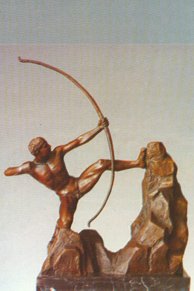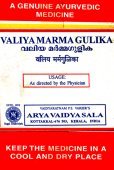Marma: 12 definitions
Introduction:
Marma means something in Hinduism, Sanskrit, Marathi, Hindi. If you want to know the exact meaning, history, etymology or English translation of this term then check out the descriptions on this page. Add your comment or reference to a book if you want to contribute to this summary article.
Alternative spellings of this word include Marm.
In Hinduism
Ayurveda (science of life)
Toxicology (Study and Treatment of poison)
Source: Shodhganga: Kasyapa Samhita—Text on Visha ChikitsaMarma (मर्म) refers to the “bitten spot” (of a snake bite) and represents an aspect of Agadatantra—“the ancient Indian science that alleviates the effects of poison”, as taught in the Kāśyapa Saṃhitā: an ancient Sanskrit text from the Pāñcarātra tradition dealing with both Tantra and Viṣacikitsā—an important topic from Āyurveda which deals with the study of Toxicology (Agadatantra or Sarpavidyā).—Tradition has it that Brahmā himself expounded the sarpavidyā to sage Kaśyapa [including topics such Marma—the bitten spot (of a snake bite)].
Unclassified Ayurveda definitions
Source: Wisdom Library: Āyurveda and botanyMarma is a medical term used in Ayurveda referring to the "vital parts".
Source: archive.org: Kalarippayattu (Ayurveda)Marma (मर्म).—In Suśruta-saṃhitā, the sixth chapter under Śārīrasthāna section is devoted to identification of marma points, their vitality and the consequences of damaged marmas. The Kalari tradition acknowledges the identification of marmas asfound in Suśruta-saṃhitā. Accordingly, it is said that there are 107 marma points and they are divided broadly into five categories as marmas of the muscular, vascular, ligament, bone and joints. Suśruta then points out the number of marmas under each of these categories. Suśruta highlights the importance of marma by identifying four typesof blood vessels (sirā) that are generally situated in the marmas that maintain the body by nourishing the ligaments, bones, muscles and joints.
Vāgbhaṭṭa following the tradition of Suśruta takes up the discussionof marmas in the fourth chapter titled Marmavibhāga of Śārīrasthāna section in his Aṣṭāṅgahṛdaya. In the Sanskrit commentary to Aṣṭāṅgahṛdaya, titled ‘Sarvāṅgasundara ’ by Aruṇadatta the word marma is derived etymologically as that place when affected (severely) causes death. Some of the names of marmas as found described in Aṣṭāṅgahṛdaya are kṣipra, kūrcaśira, gulpha, indrabasti, jānu, āṇi, urvi, lohitākṣa, viṭapa, guda etc.

Āyurveda (आयुर्वेद, ayurveda) is a branch of Indian science dealing with medicine, herbalism, taxology, anatomy, surgery, alchemy and related topics. Traditional practice of Āyurveda in ancient India dates back to at least the first millenium BC. Literature is commonly written in Sanskrit using various poetic metres.
Vastushastra (architecture)
Source: The India Center: Architecture (Vastu Shastra)A Mandala (architectural plan which represents the cosmos) has certain points known as Marma which are vital energy spots on which nothing should be built. They are determined by certain proportional relationships of the squares and the diagonals.

Vastushastra (वास्तुशास्त्र, vāstuśāstra) refers to the ancient Indian science (shastra) of architecture (vastu), dealing with topics such architecture, sculpture, town-building, fort building and various other constructions. Vastu also deals with the philosophy of the architectural relation with the cosmic universe.
Dhanurveda (science of warfare)
Source: archive.org: KalarippayattuMarma (मर्म).—The Kalari tradition acknowledges the identification of marmas asfound in Suśruta-saṃhitā. The Northern Kalari tradition follows the manna based on Suśruta and Vāgbhaṭṭa. However, the names of the marmas are given in Malayalam like chumayan, kazhuttukochi, kirikoḍam etc. The Kalari tradition identifies 64 marma points called abhyāsa-marma, of which 32 points can be aimed at during a combat and other 32 points can be aimed at when the opponent is immobilized and these points are aimed at unexpectedly. Again, 12 points aimed at by vaḍi or katti results in death and other 6 points aimed at by hand leads to immediate death.
Source: Knowledge Traditions & Practices of India: Martial Arts Traditions: A SurveyMarma (मर्म) refers to the ‘vital points’, as defined according to ancient Indian martial arts (dhanurveda).—The final stage of Kalarippayattu training involves Ayurvedic treatments for body and mind, techniques of marma (vital points) and therapeutic massages. The student learns how to treat injuries and diseases resulting from trauma. After the training, the kalari expert also becomes a healer.

Dhanurveda (धनुर्वेद) refers to the “knowledge of warfare” and, as an upaveda, is associated with the Ṛgveda. It contains instructions on warfare, archery and ancient Indian martial arts, dating back to the 2nd-3rd millennium BCE.
Purana and Itihasa (epic history)
Source: archive.org: Shiva Purana - English TranslationMarma (मर्म) refers to the “vulnerable points”, according to the Śivapurāṇa 2.2.28. Accordingly as Śiva said to Satī:—“[...] people wounded with arrows by enemies are not so pained as when their vulnerable points (marma) are hit by the taunting words of kinsmen. O beloved, the wicked people do not observe that their own status is being hit when they attack good men endowed with the six qualities of learning”.

The Purana (पुराण, purāṇas) refers to Sanskrit literature preserving ancient India’s vast cultural history, including historical legends, religious ceremonies, various arts and sciences. The eighteen mahapuranas total over 400,000 shlokas (metrical couplets) and date to at least several centuries BCE.
Languages of India and abroad
Marathi-English dictionary
Source: DDSA: The Molesworth Marathi and English Dictionarymarma (मर्म).—n (S) Secret quality; the latent power, property, or virtue of. Ex. sarva padārthāmadhyēṃ jīṃ īśvarānēṃ marmēṃ ṭhēvilīṃ āhēta tīṃ kōṇhāsa samajatāta? 2 A vital member or organ; a mortal spot. Hence fig. A vulnerable point; a sore or tender place; a secret failing or foible. 3 The secret meaning or purpose (of a passage, a speech &c.); the point, sting, bearing, aim, drift. 4 The art, trick, secret, mystery; the hidden skill or appropriate mode (of a contrivance, a process, a business). Ex. ghaḍyāḷāntalēṃ marma samajata nāhīṃ; adyāpi ślōka lāvaṇyācēṃ marma tulā samajalēṃ nāhīṃ. 5 The enemy or antidote; the corrective; the thing of opposite and counteracting qualities. Ex. kēḷācēṃ marma tūpa; gaṃvhācēṃ marma kāṅkaḍī.
Source: DDSA: The Aryabhusan school dictionary, Marathi-Englishmarma (मर्म).—n Secret quality. A vital member. The secret meaning. The secret. The antidote, corrective. Ex. kēḷyācēṃ marma tūpa gavhācēṃ marma kākaḍī.
Marathi is an Indo-European language having over 70 million native speakers people in (predominantly) Maharashtra India. Marathi, like many other Indo-Aryan languages, evolved from early forms of Prakrit, which itself is a subset of Sanskrit, one of the most ancient languages of the world.
Sanskrit dictionary
Source: Cologne Digital Sanskrit Dictionaries: Monier-Williams Sanskrit-English DictionaryMarma (मर्म):—[from marman] in [compound] for marman.
Sanskrit, also spelled संस्कृतम् (saṃskṛtam), is an ancient language of India commonly seen as the grandmother of the Indo-European language family (even English!). Closely allied with Prakrit and Pali, Sanskrit is more exhaustive in both grammar and terms and has the most extensive collection of literature in the world, greatly surpassing its sister-languages Greek and Latin.
Hindi dictionary
Source: DDSA: A practical Hindi-English dictionaryMarma (मर्म) [Also spelled marm]:—(nm) vulnerable / vital part (of the body); essence; core; secret; real meaning; ~[ghātī] one who strikes at the most vulnerable point, who makes a fatal stroke; ~[jña] one who knows the inner meaning; having deep penetration into the secret; ~[pīḍā/vedanā/vyathā] intense mental agony; -[prahāra] fatal stroke, vital stroke; -[bheda] revelation of a secret; see -[prahāra; bhedī] moving, touching; poignant; heart-rending; —[vacana] touching words; subtle words; —[vākya] secret/real utterance; ~[bedhī] see ~[bhedī; ~sthala] a vulnerable point; vital spot; —[jānanā] to know the inner secret; —[chūnā] to touch one’s inner being, to move deeply; —[pānā] to get at the depth of, to know profoundly; —[lenā] to try to know the essence of.
...
Kannada-English dictionary
Source: Alar: Kannada-English corpusMarma (ಮರ್ಮ):—[noun] a son of one’s son or daughter; a grandson.
--- OR ---
Marma (ಮರ್ಮ):—
1) [noun] any vital, sensitive or vulnerable spot or part of the body.
2) [noun] any of the places or parts where two bones are joined, so that they can move; a joint.
3) [noun] the mind or heart as the seat for inner feelings.
4) [noun] something hidden or that requires to be kept concealed; a secret or mystery.
5) [noun] the hidden meaning or interior motive.
6) [noun] a man appointed to execute something in a secret or clandestine manner.
Kannada is a Dravidian language (as opposed to the Indo-European language family) mainly spoken in the southwestern region of India.
See also (Relevant definitions)
Starts with (+81): Marmabheda, Marmabhedaka, Marmabhedaki, Marmabhedana, Marmabhedi, Marmabhedin, Marmabhid, Marmabhighata, Marmabhihata, Marmacara, Marmaccheda, Marmacchedi, Marmacchedin, Marmacchid, Marmachara, Marmachhid, Marmachid, Marmaga, Marmaghat, Marmaghata.
Ends with: Abhihatamarma, Adhimarma, Adhomarma, Amarma, Ashmarma, Kavyamarma, Madrashmarma, Nagamarma, Olamarma, Paramarma, Pradhanamarma.
Full-text (+90): Marmabhedin, Marmajna, Marmavid, Marmasprish, Marmatadana, Marmasthala, Vibhedin, Marmam, Kurcashiras, Marmavedhita, Vitapa, Kshipra, Urvi, Lohitaksha, Gulpha, Marmavarana, Marmavedhin, Marmavibhedin, Ani, Janu.
Relevant text
Search found 29 books and stories containing Marma; (plurals include: Marmas). You can also click to the full overview containing English textual excerpts. Below are direct links for the most relevant articles:
Sushruta Samhita, volume 3: Sharirasthana (by Kaviraj Kunja Lal Bhishagratna)
Chapter VI - The Marmas (vital parts of the body)
Chapter VIII - The method of Venesection
Sushruta Samhita, volume 2: Nidanasthana (by Kaviraj Kunja Lal Bhishagratna)
Sushruta Samhita, volume 1: Sutrasthana (by Kaviraj Kunja Lal Bhishagratna)
Chapter XXVI - Knowledge of foreign bodies
Chapter XXV - Eight kinds of surgical operations
The Garuda Purana (by Manmatha Nath Dutt)
Chapter CLXXXIII - The Nidanam of Goitre scrofula and glandular swellings < [Dhanvantari Samhita]
Chapter CL - The Nidanam dyspaksea < [Dhanvantari Samhita]
Chapter CXC - The Nidanam of Sarira Vranas (idiopathic ulcers) < [Dhanvantari Samhita]
Hari-bhakti-kalpa-latikā (by Sarasvati Thkura)
Text 45 < [Second Stabaka]
Chaitanya Bhagavata (by Bhumipati Dāsa)
Verse 1.4.115 < [Chapter 4 - Name-giving Ceremony, Childhood Pastimes, and Thieves Kidnap the Lord]
Verse 1.5.77 < [Chapter 5 - Eating the Mendicant Brāhmaṇa’s Offerings]
Verse 3.3.116 < [Chapter 3 - Mahāprabhu’s Deliverance of Sarvabhauma, Exhibition of His Six-armed Form, and Journey to Bengal]
Related products
